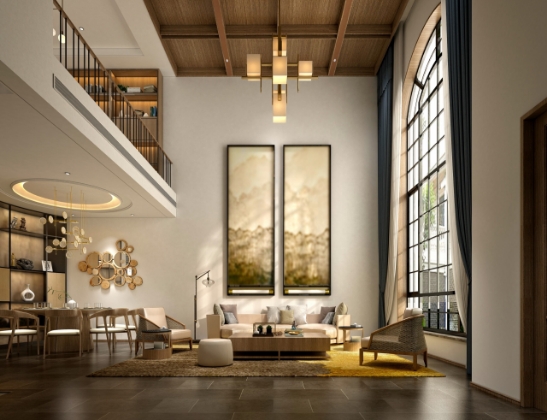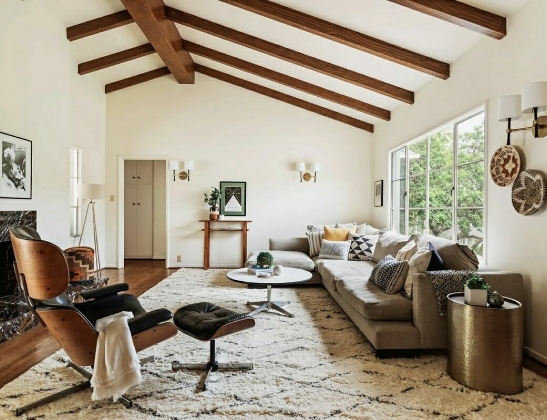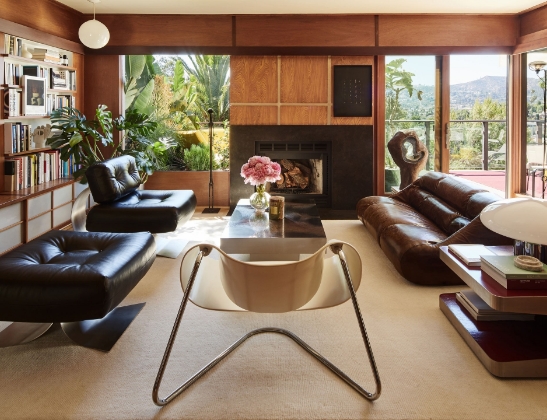Midcentury Modern vs Modern Interior Design Styles
Posted: February 13, 2024
In the ever-evolving realm of interior design, two iconic styles stand out with their unique charms and timeless appeal. Let's delve into the distinctive features of midcentury modern and modern interior design, exploring the nuances that make each a captivating choice for today's sophisticated homeowners.

What Is a Midcentury Modern Design Style?
Midcentury Modern design, hailing from the mid-20th century, continues to capture hearts with its clean lines, organic shapes, and a seamless blend of form and function. This style, characterized by a love for simplicity and a focus on functionality, has endured the test of time.
Step into a midcentury modern space, and you'll be greeted by a sense of openness and simplicity. Furniture pieces boast sleek lines, often featuring iconic designs from legendary mid-century designers. The use of natural materials like wood and a neutral color palette contributes to the warm and inviting atmosphere.
A hallmark of midcentury modern design is the incorporation of nature into the living space. Large windows, open floor plans, and a harmonious connection with the outdoors define this style. Embrace the beauty of nature while maintaining a modern, sophisticated ambiance.
What Is a Modern Design Style?
In contrast, modern interior design takes inspiration from the present and future, creating spaces that reflect the contemporary spirit. This style embraces technology, innovative materials, and a commitment to sleek, uncluttered aesthetics.
Modern design celebrates the technological age, integrating smart home features seamlessly into the living space. From automated lighting systems to voice-controlled appliances, every element serves a purpose, contributing to a lifestyle that effortlessly blends convenience and style.
Modern interiors thrive on simplicity, favoring a clutter-free environment. Clean lines, geometric shapes, and a monochromatic color scheme define this style. The emphasis on simplicity doesn't compromise on elegance, creating spaces that exude sophistication and modernity.
Main Differences: Midcentury Modern vs Modern Decor
Here is a list of the main differences between these two popular interior design styles:
Time Period:
- Midcentury Modern: Originating in the mid-20th century, particularly from the 1940s to the 1960s.
- Modern: Reflects contemporary design trends, often associated with the present and future.
Design Philosophy:
- Midcentury Modern: Embraces simplicity, functionality, and a connection with nature. Characterized by clean lines and organic shapes.
- Modern: Focuses on sleek aesthetics, technological integration, and a commitment to uncluttered spaces with clean lines and geometric shapes.
Materials and Textures:
- Midcentury Modern: Utilizes natural materials like wood, with an emphasis on warmth. Incorporates textures for a cozy and inviting feel.
- Modern: Features a preference for innovative materials, often with a monochromatic color scheme. Strives for a minimalist and sophisticated look.
Integration of Technology:
- Midcentury Modern: While not technology-driven, it can accommodate modern amenities. Technology is subtly integrated into the design.
- Modern: Actively embraces technological advancements, seamlessly incorporating smart home features for convenience and efficiency.
Color Palette:
- Midcentury Modern: Embraces a neutral color palette with occasional pops of bold colors. Earthy tones contribute to a warm ambiance.
- Modern: Often adopts a monochromatic color scheme, leaning towards neutral and muted tones to create a clean and timeless aesthetic.
Furniture Design:
- Midcentury Modern: Features iconic furniture designs from mid-century designers. Clean lines and functional pieces are key elements.
- Modern: Showcases contemporary furniture with a focus on simplicity and functionality. Geometric shapes and minimalist forms dominate.
Connection with Nature:
- Midcentury Modern: Prioritizes a harmonious connection with the outdoors, featuring large windows and open floor plans.
- Modern: While not a central theme, may incorporate elements of nature but emphasizes sleek and efficient design.
Overall Atmosphere:
- Midcentury Modern: Projects a nostalgic and timeless ambiance with a blend of simplicity and sophistication.
- Modern: Evokes a contemporary and forward-thinking atmosphere, characterized by a blend of technology and minimalist aesthetics.
Finding Your Style
Ultimately, whether you lean towards the classic allure of midcentury modern or the contemporary vibes of modern interior design, the key is to create a space that resonates with your personal style.
Your home is a canvas, and these design styles offer the brushstrokes to craft an environment that is both visually stunning and functionally efficient. Have fun with your space, you can even try merging these two styles for a unique look.
Furniture Store Near You
Are you ready to revamp your home? Visit our furniture store location in Fond du Lac, WI, to begin browsing. We carry a great selection of the best living room furniture, bedroom furniture, dining room furniture, home office furniture, and so much more.
Discover a world of exquisite design and unparalleled comfort at our furniture store in Fond du Lac, WI. Elevate your living experience with our curated collection of the finest furniture pieces, meticulously selected to suit every corner of your home.
Indulge in the luxury of top-notch furniture without breaking the bank. We believe in making elegance accessible to all, ensuring every piece in our store combines affordability with enduring quality. Whether you seek the timeless allure of midcentury modern or the sleek sophistication of modern design, find the perfect pieces to reflect your style.
Shop our range of sofas, tables, chairs, dressers, mirrors, and more to complete your home. At Silica, we're not just selling furniture; we're crafting lifestyles. Embrace the elegance—your dream home awaits!
Related Readings:
Midcentury Modern vs Modern: Commonly Asked Questions
What defines midcentury modern design?
Midcentury Modern design is characterized by its origins in the mid-20th century, featuring clean lines, organic shapes, and a focus on simplicity and functionality. It often incorporates natural materials like wood and embraces a connection with nature.
How does modern design differ from midcentury modern?
Modern design is more contemporary, reflecting present and future design trends. It emphasizes sleek aesthetics, technological integration, and a minimalist approach with clean lines, geometric shapes, and a preference for innovative materials.
What color palettes are typical for midcentury modern and modern design?
Midcentury Modern tends to embrace a neutral color palette with occasional pops of bold colors. Modern design often adopts a monochromatic color scheme, favoring neutral and muted tones for a clean and timeless look.
Can I blend midcentury modern and modern styles in my home?
Absolutely! Many homeowners create a harmonious fusion by blending the timeless charm of midcentury modern with the sleek elegance of modern design. Experimenting with iconic pieces and modern elements can result in a unique and personalized space.
Do these styles have specific preferences for home layouts?
Midcentury Modern often favors open floor plans and large windows, emphasizing a connection with the outdoors. Modern design, while not strictly tied to a specific layout, tends to prioritize sleek and uncluttered spaces.
How do I decide which style suits my home?
Consider your personal preferences, lifestyle, and the existing aesthetics of your home. Explore both styles, noting the key features and elements that resonate with you. You may also opt for a blend that combines the best of both worlds.



Featured Products
Be The First To Know
Sign up to get access to deals, inspiration, trends, and more!


